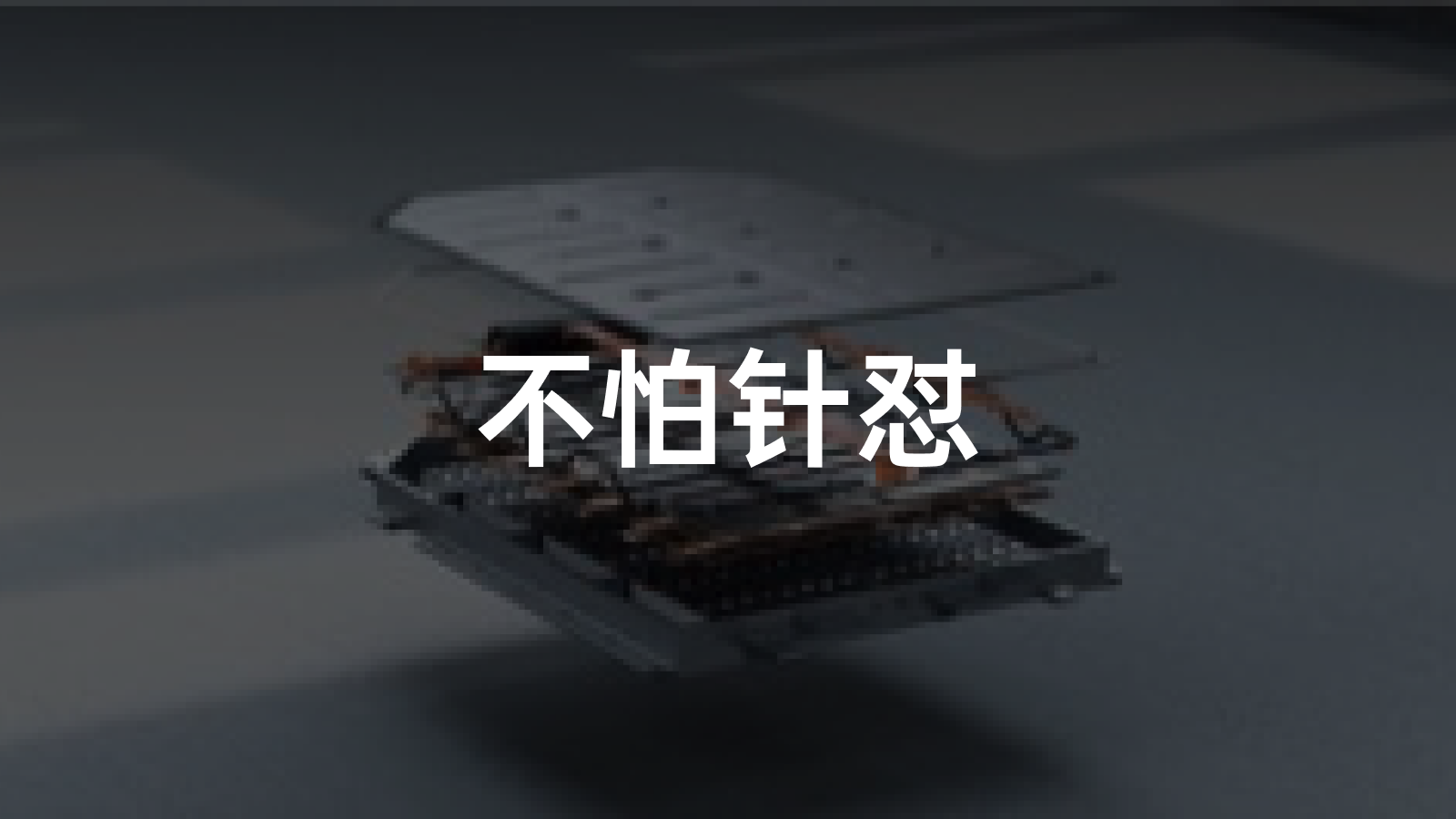The Geely K-One 001, released on April 15th, has become a popular topic in the new energy industry over the past few months, capturing the hearts of prospective buyers with its rugged appearance and attractive features.
As an electric vehicle, the most impressive feature of the K-One 001 is undoubtedly its large battery and accompanying 712 km NEDC range, which is unmatched in the industry for a mid-sized electric vehicle priced at less than 300,000 yuan.
However, as the old saying goes, you get what you pay for, and the higher energy consumption compared to competitors has raised concerns about the quality and safety of the K-One’s large capacity battery.
Safety, a Concern for All Electric Vehicles
For most consumers, safety is a major consideration when purchasing a vehicle, and for electric vehicles, battery safety is a key factor, as no one wants to be in the middle of an EV fire.
To address this common concern, the new energy market in China has seen a growing trend in battery safety competitions, with BYD winning accolades for its lithium iron phosphate battery’s stability and resilience during puncture tests, earning the catchy moniker of “blade battery,” making it a household name in the industry.
This success by BYD has significant implications for the industry: from the perspective of automakers, battery safety is a complex engineering challenge, and communicating this information to consumers is also a difficult task, making these tests and competitions an excellent way to demonstrate the ability to withstand extreme conditions. From a consumer perspective, these tests are more intuitive than technical specifications, giving them insight into how the battery will perform in worst-case scenarios.
However, it is important to note that there are differences in the severity and scope of these tests, even among similar “abuse” tests.
A Wide Variety of “Pressure Tests”
There are various types of rigorous tests related to batteries, including but not limited to overcharging, overdischarging, water immersion, crushing, salt spray, and jetting. For electric vehicle batteries, the most severe test by far is the thermal runaway test, which is the number one “torture” among numerous types of tests.
So what is a thermal runaway test?
Simply put, a thermal runaway test is designed to simulate internal thermal runaway in the battery system using specific methods, in order to mimic the possibility of the battery catching on fire under extreme conditions.
The most common thermal runaway tests in the industry include piercing, heating, and short-circuiting, which inevitably lead to internal short circuits in the battery cells and then thermal runaway.Last Friday, Geek+ released the results of their battery pack thermal runaway test.
Geek+ “stabbed” rather than “pricked” this time
Among various thermal runaway tests, Geek+ chose to challenge the needle puncture test this time. Compared to other ways of triggering thermal runaway, needle puncture not only causes thermal runaway, but also causes physical damage to the battery, which can better simulate the situations in real life, such as severe undercarriage collisions or bottoming out.
Next, let’s take a look at the highlights of this test. Technically speaking, Geek+’s needle puncture test this time can be said to be of the highest difficulty. First of all, the steel needle used in this test is the biggest 8mm steel needle in the national standard, which increases the damage to the battery and the short circuit caused by the larger piercing range, making the process of thermal runaway more intense.
Secondly, what surprised me is that the puncture direction this time is not the Z direction of the thickness of the battery pack, but the X direction of the length of the battery pack, which is the length of the steel needle at the beginning of the puncture.
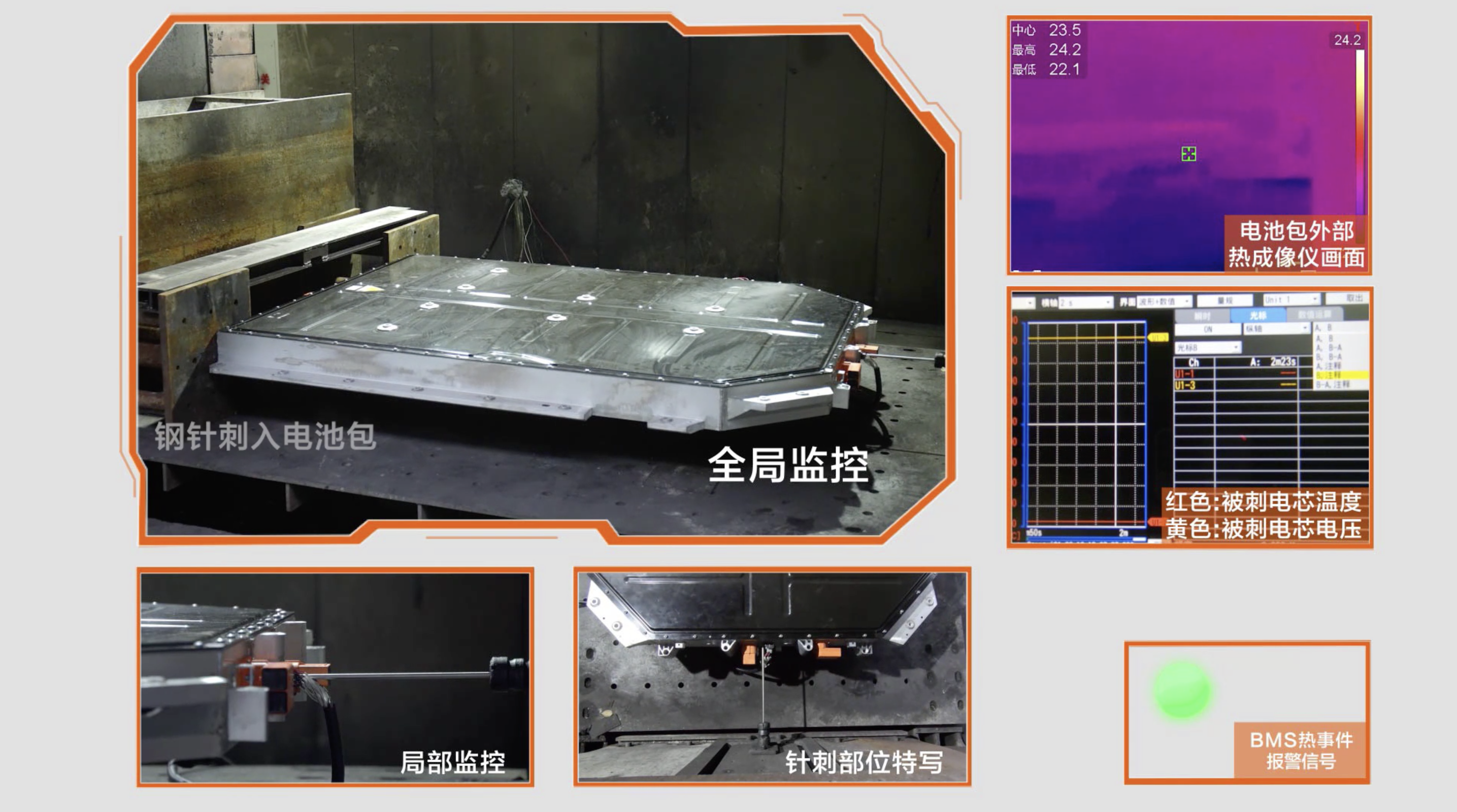
The following figure shows the final position where the steel needle stopped during the experiment. It can be seen that the several tens of centimeters long steel needle almost completely penetrated the middle of the battery pack, and the whole section of the steel needle fully “injured the vital part”. Compared to a “prick,” it was more like a “stab” and the “depth of the wound” inside the pack was self-evident.
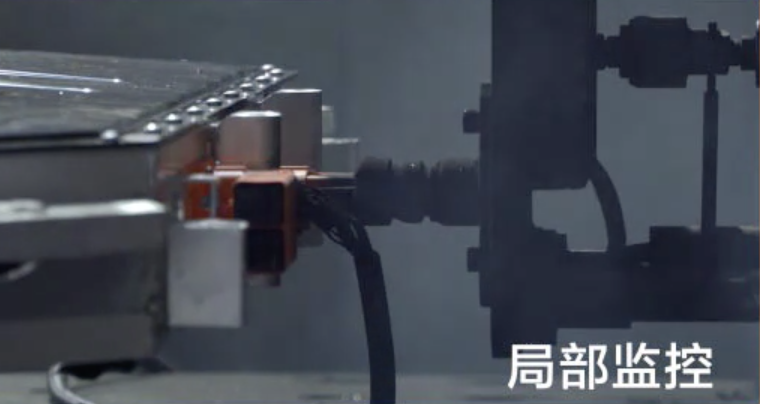
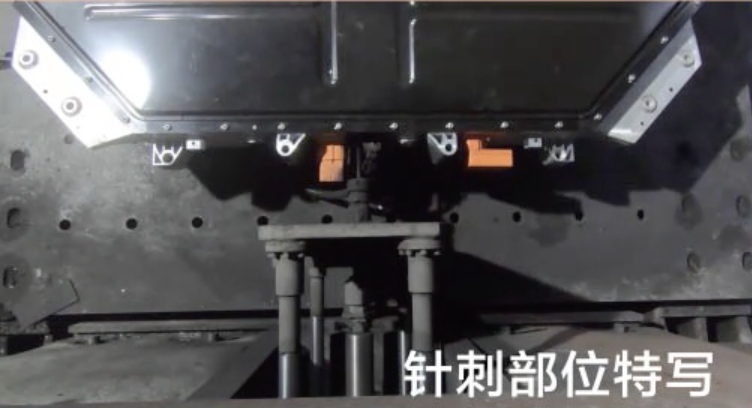
Moreover, the position of the needle puncture in the test happened to be near the rear of the car, which was relatively close to the actual collision scenario.
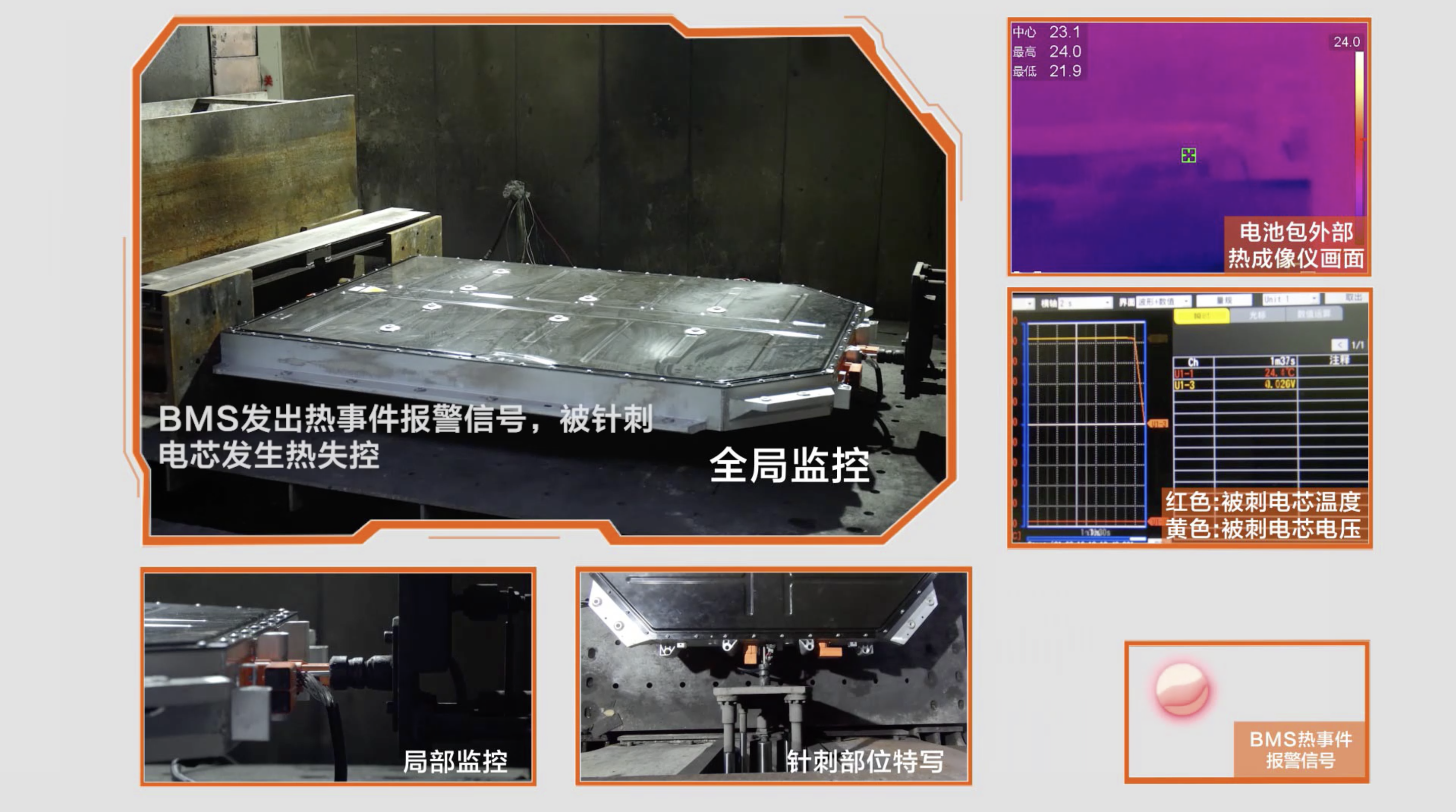
When the steel needle penetrated the battery pack and first injured the battery cell, the BMS alarm signal appeared rapidly. At this time, the battery cell short circuit had just started, and the temperature of the battery pack recorded by the infrared camera was only 24 ℃.During the following period of time, the short-circuited battery cell began to react violently, generating a large amount of smoke which poured out from the exhaust valve. This actually indicates that the battery pack system has been prepared for thermal runaway, promptly discharging reaction gas to complete the pressure relief task, avoiding excessive expansion of the battery pack.
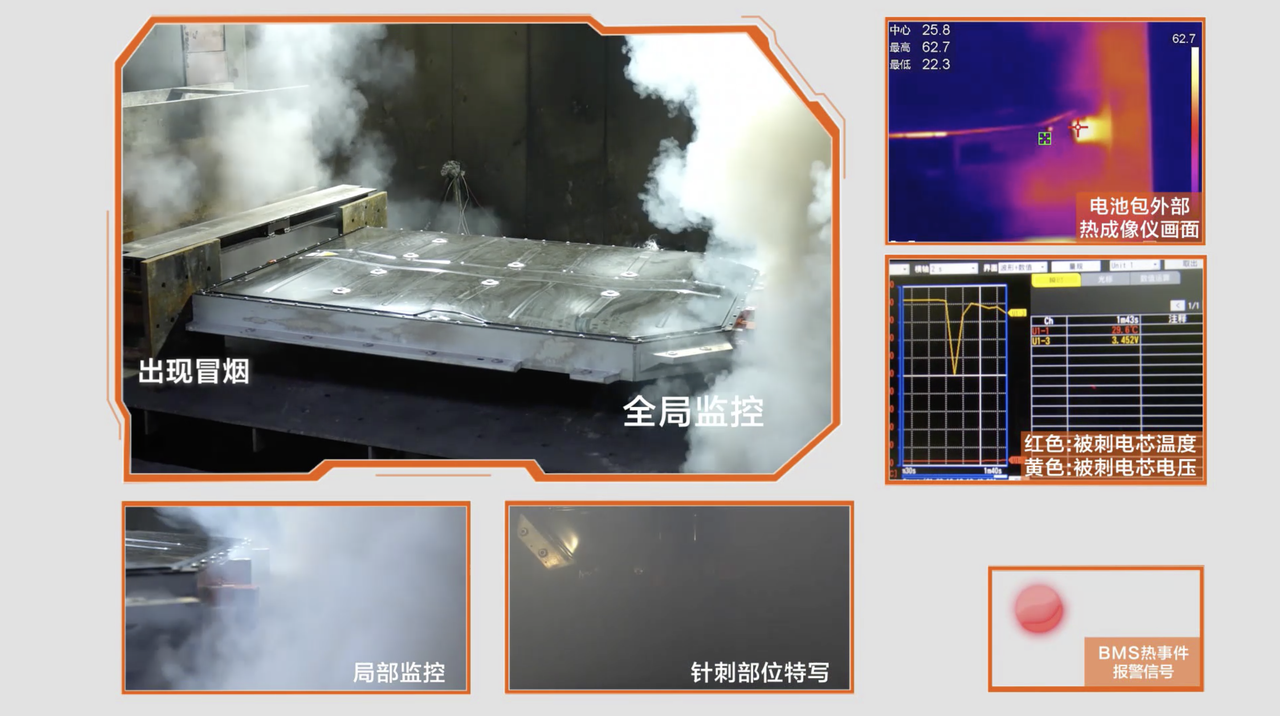
During the following test period, the temperature of the punctured cell reached 801.4 ℃ at one point and maintained above 790 ℃ for some time, but there were no flames detected from the outside of the battery pack. The battery pack shell under camera surveillance did not show any melting or cracking.
After the reaction smoke was discharged during the 24-hour resting period after the battery pack was punctured, there were no other anomalies on the outside of the battery pack. Observing the battery pack after taking it down from the test bench, the structural integrity of the battery pack was intact. Not only were there no signs of serious damage on the outside, but also the electroplating layer above the puncture remained intact.
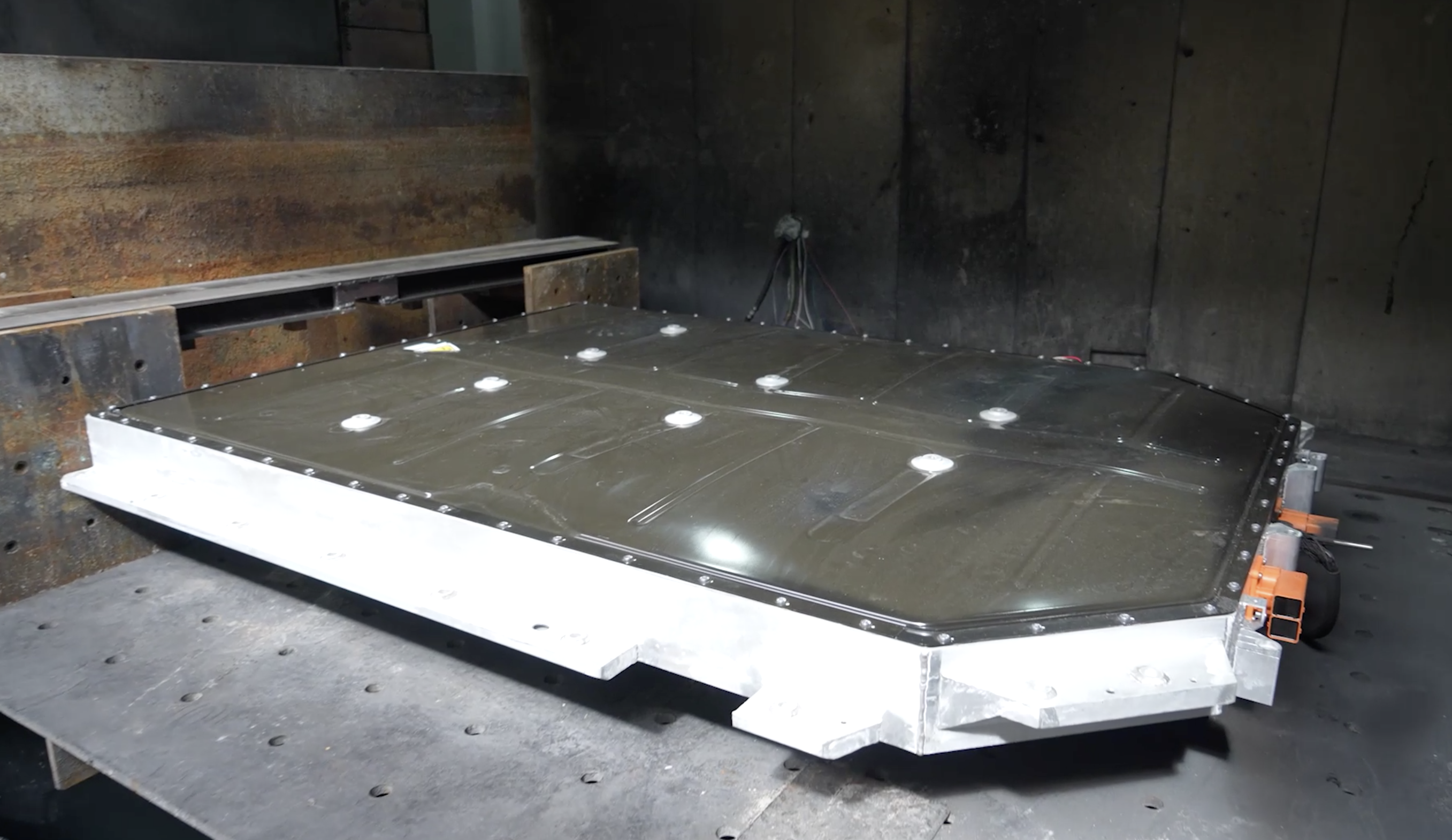
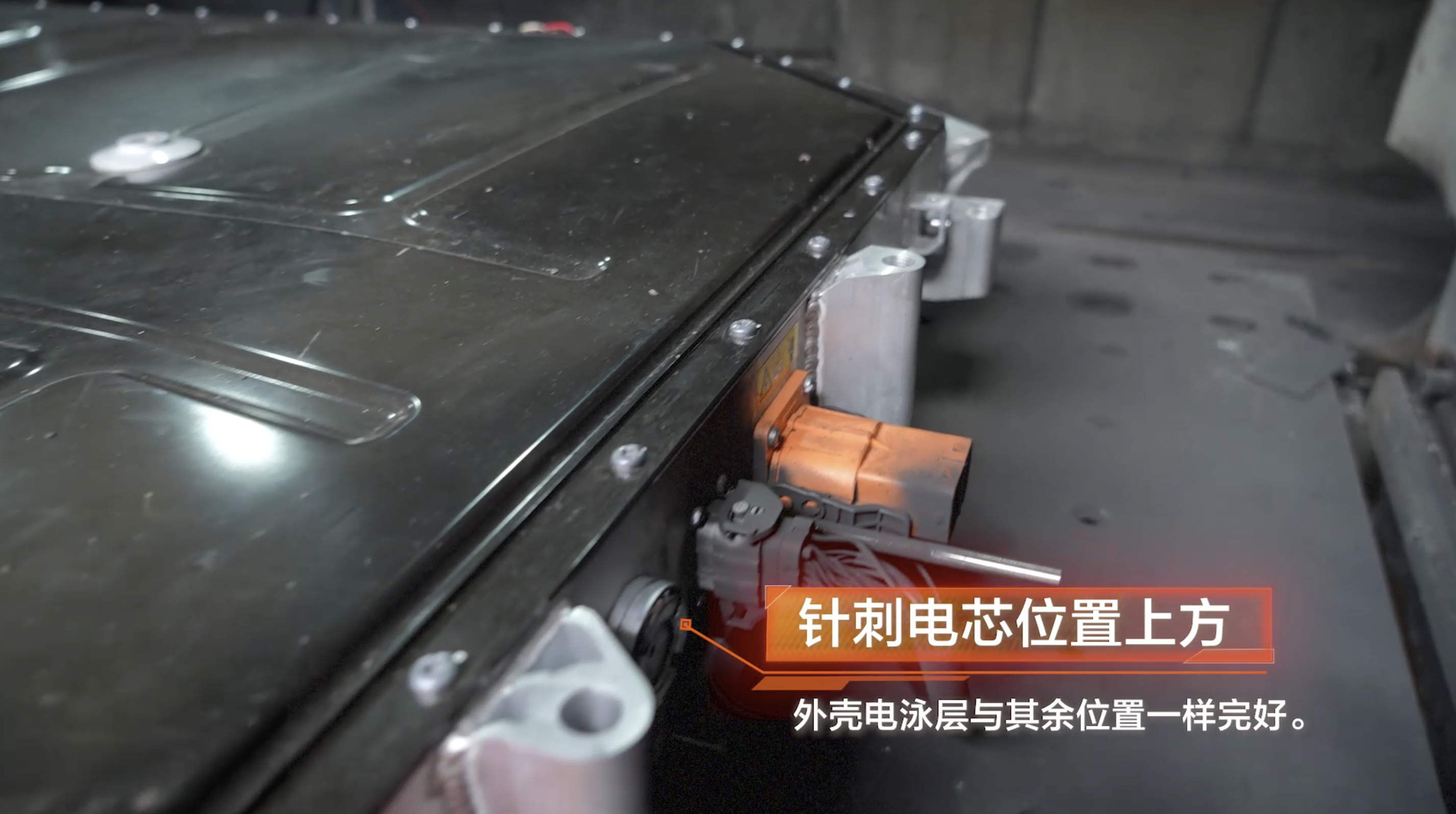
However, the internal condition of the battery pack is even more surprising. After removing the battery pack cover, various fixed structures inside the battery pack were still intact, except the module at the top that was punctured. It is also easy to see that the cells in the punctured module were tightly packed, which is the biggest and most critical challenge of the thermal runaway test – to prevent thermal runaway from causing a chain reaction and spreading to other cells.
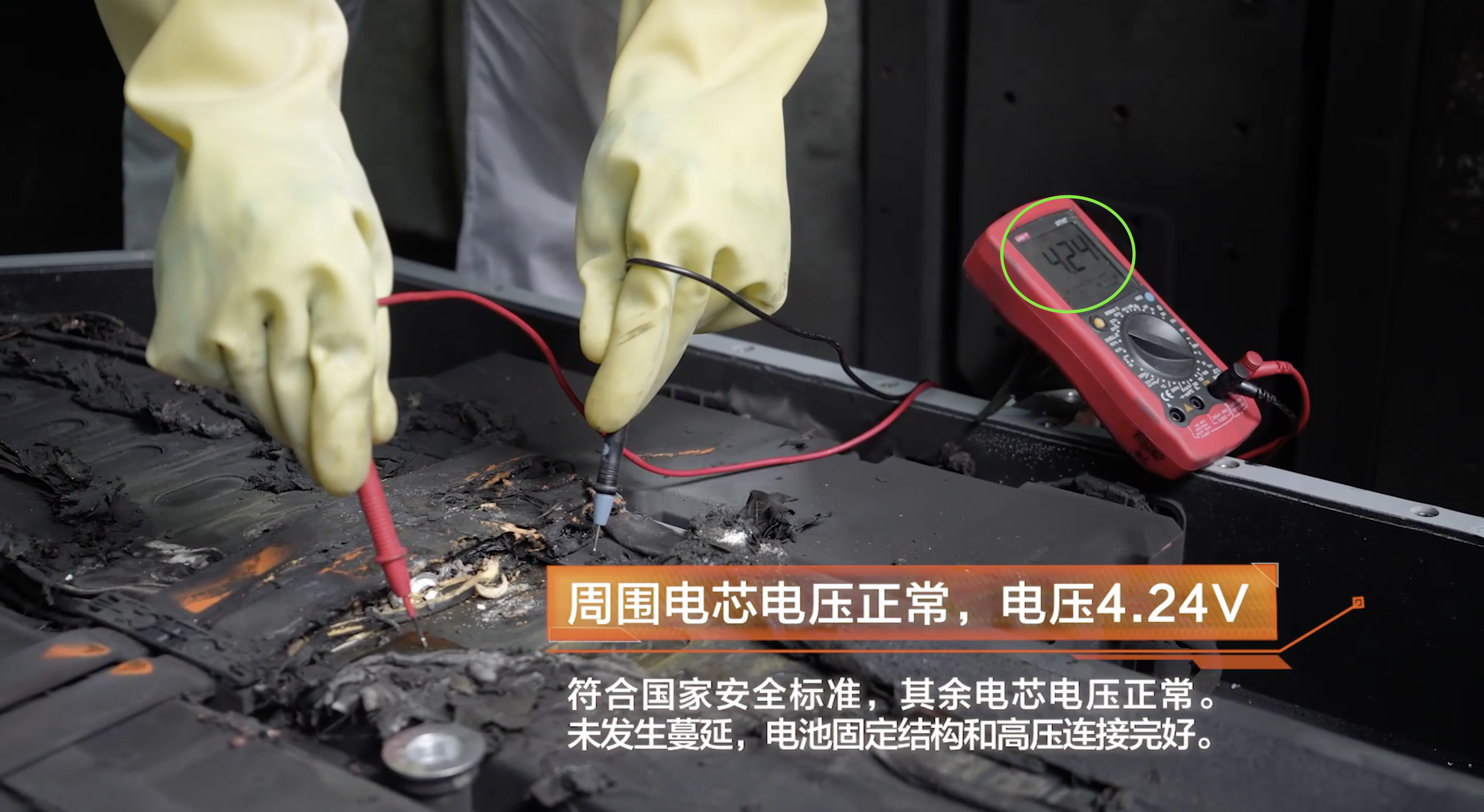
The measured voltage results show that the voltage of the punctured cell has dropped to 0 V, but the cells around it are still at 4.24 V, which is normal. This key data is of great significance: the cells around the punctured cell were not affected by the thermal runaway, and no thermal propagation occurred.
 The summary of the key results of this penetration test is presented in this report. In a single sentence: under the rigorous puncture conditions, the battery pack did not catch fire or explode, and alerted in time. Its internal and external critical structures remained intact, and most importantly, there was no thermal runaway. This fully meets the requirements of the UL2580 standard, which is the world’s most stringent standard for battery thermal runaway, that there should be no open flames or explosions within 1 hour.
The summary of the key results of this penetration test is presented in this report. In a single sentence: under the rigorous puncture conditions, the battery pack did not catch fire or explode, and alerted in time. Its internal and external critical structures remained intact, and most importantly, there was no thermal runaway. This fully meets the requirements of the UL2580 standard, which is the world’s most stringent standard for battery thermal runaway, that there should be no open flames or explosions within 1 hour.
Puncture is not the protagonist, the battery is
The excellent performance of this battery pack in the thermal runaway test can be attributed to several factors.
Firstly, the battery must have a strong heat dissipation capacity. Approximately 70\% of the energy released from the battery cell short circuit triggering thermal runaway is released in the first minute, during which if the heat is not dissipated in time, the continuous temperature rise may cause the chemical substances inside the cell to burn, leading to the combustion of the battery pack.
To prevent this problem, the key point is whether the battery pack can efficiently and unobstructedly release high-temperature gas after thermal runaway occurs. This is why the Extreme Kr battery pack has reserved a dedicated unobstructed exhaust path, and has pressure relief valves installed at both ends of the battery pack. In the puncture test, it can be seen that the battery pack promptly released this part of the gas after thermal runaway occurred, avoiding the accumulation of pressure and heat.
Secondly, insulation must be done to the extreme. After thermal runaway occurs, the most dangerous thing is the adjacent cells. If the conduction of heat is not blocked during this process, it can easily raise the temperature of the adjacent cells above the danger line, which is the beginning of the chain reaction of thermal runaway propagation. Therefore, Extreme Kr has adopted many insulation and barrier measures inside the battery pack, including but not limited to the use of high-standard fire insulation materials in various key parts, and the design of partitions between modules. Starting from the heat-conducting end, it ensures that the thermal runaway will not affect the entire battery pack.
In addition to the above two aspects, during this period, the battery pack’s liquid cooling temperature control system is also actively cooling the battery system, taking away as much heat as possible from the reaction site. At the moment when thermal runaway occurs, the BMS alerts are not only known by the system, but will also be promptly alerted to the driver or passengers through various means such as the central control system, ambient lights, and phone messages. At the same time, the high-voltage circuit of the battery pack will be cut off within milliseconds after a short circuit occurs, minimizing the impact of the short circuit on the entire battery system.
During the battery cell’s life cycle, the BMS also monitors and regulates the status of each cell to avoid the hidden danger of accumulative thermal runaway caused by the poor consistency of cell voltage, thus nipping it in the bud.
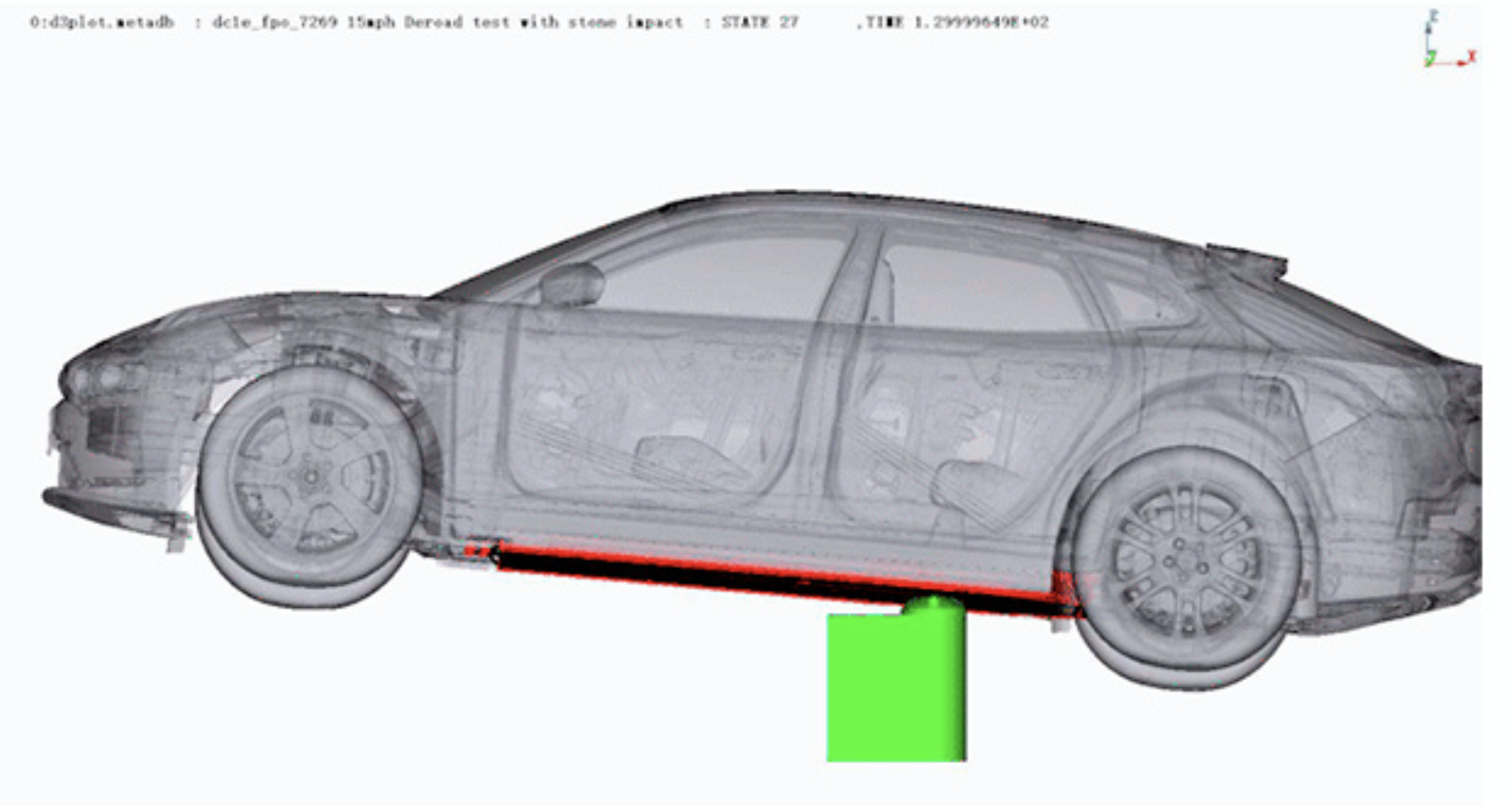 Except for the battery pack, the body structure of the Zeekr 001 has also been specially reinforced, such as the horizontally formed aluminum alloy anti-collision beam on the vehicle chassis and the anti-skid plate under the battery pack.
Except for the battery pack, the body structure of the Zeekr 001 has also been specially reinforced, such as the horizontally formed aluminum alloy anti-collision beam on the vehicle chassis and the anti-skid plate under the battery pack.
Yes, We Want It All
Healthy food can be delicious, and fuel-efficient engines can have strong power. For power batteries, safety should not be in opposition to battery performance.
Therefore, “JiXin” is a ternary lithium battery. Compared with lithium iron phosphate batteries, it has higher energy density, which means it has a larger charge capacity with the same volume. A large battery is the basic guarantee for the range of electric vehicles. Another point that cannot be ignored is that ternary lithium batteries have a chemical “innate advantage” over lithium iron phosphate batteries in low-temperature activity, resulting in less attenuation in winter.
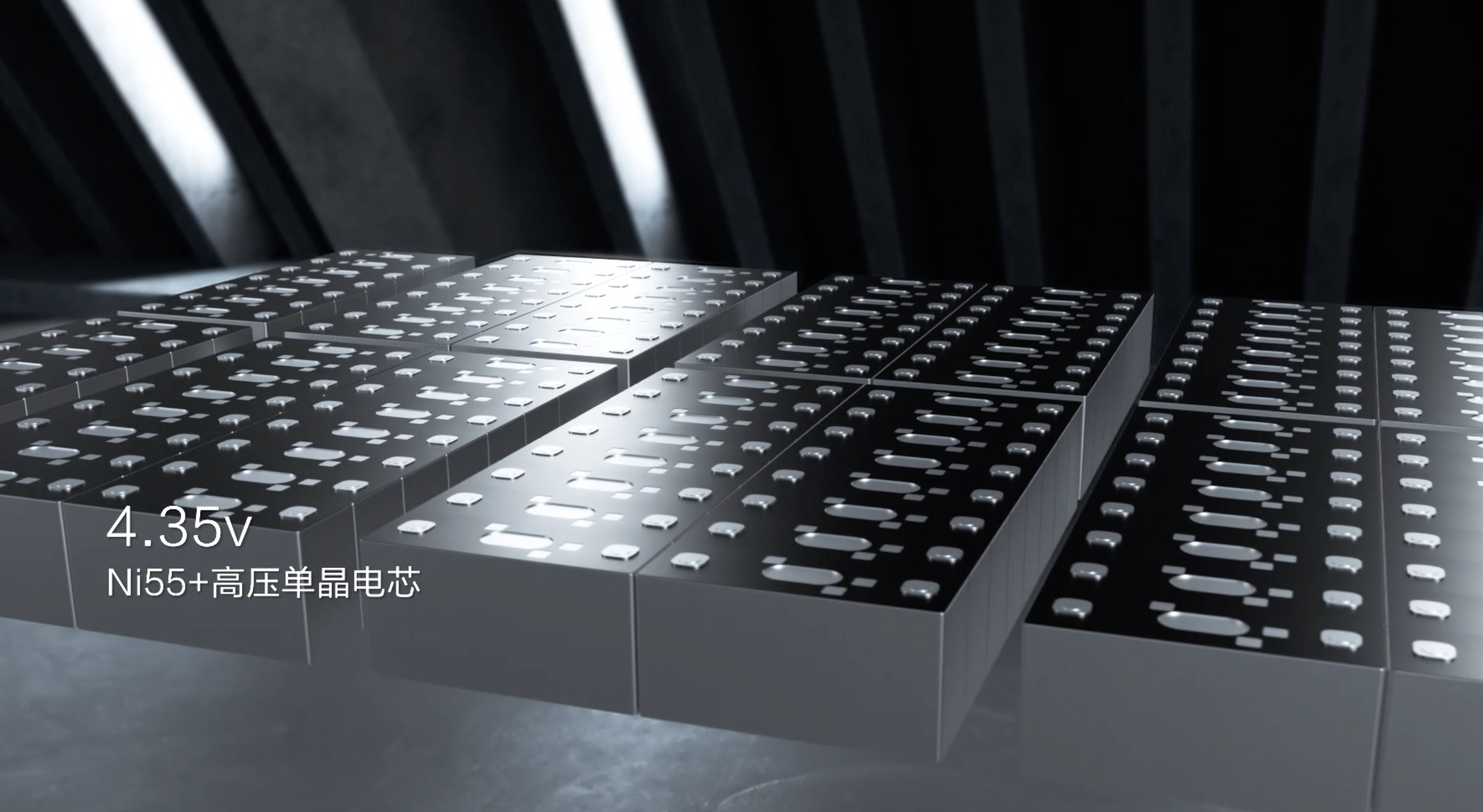
Talking about chemical performance, the positive electrode of “JiXin” this time did not adopt the high-nickel formula of 811, but the relatively mild and balanced formula of the 5 series. On this basis, a single-crystal Ni55+ material was further used, which not only improves the thermal stability of the battery, but also reduces the cost due to the lower nickel usage. Thanks to the fact that Ni55+ battery cells can support higher single-cell voltages, the energy density of the battery is still at a high level in the end.
Therefore, under the premise of high safety, the “JiXin” battery still did not sacrifice any battery performance. Yes, we want it all, why not?
In Conclusion
Friends who pay attention to the new energy industry should know that “JiXin” is not the first battery pack to pass the nail-through test, nor is it the first ternary lithium battery pack to pass the needle-through test, but this needle-through test still has a very important meaning.
On the one hand, “JiXin” once again proves to the world that ternary lithium batteries can also pass rigorous whole-package puncture tests. More importantly, the highlighted price of the Zeekr 001 reveals another message: the commercialization of this technology is already mature, its cost is controllable, and it can be mass-produced.
And I noticed a detail – Zeekr did not heavily promote the needle-through test at the press conference.
In my opinion, the calm release of this test reflects an attitude: battery safety should be a basic product strength of an electric car.
In my opinion, this is a kind of confidence and also a tacit understanding with target users.
This article is a translation by ChatGPT of a Chinese report from 42HOW. If you have any questions about it, please email bd@42how.com.
